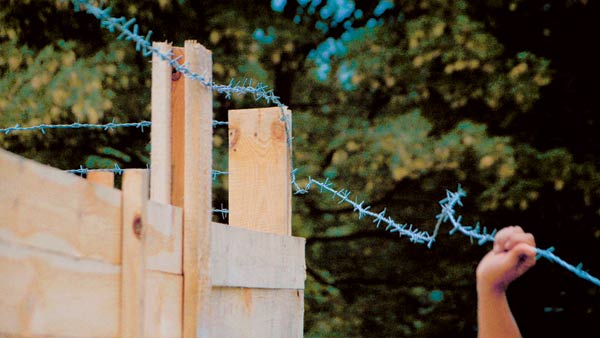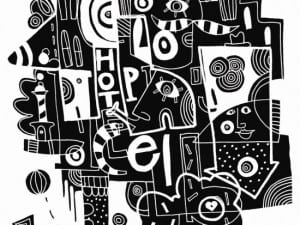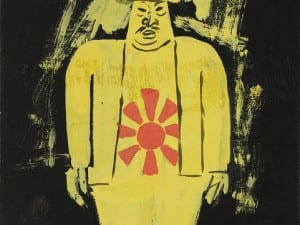With the 20th century came bloodshed and genocide on a scale so vast and industrial even now it barely seems fathomable. The Nazi’s final solution stands out as the most heart wrenching. Now, the Ikon Gallery sees Yael Bartana’s And Europe Will Be Stunned, a trilogy of films based loosely on history, but strongly fabricated, to examine the darkest years of Bartana’s own religious persuasion, Judaism. Bartana’s nationality is also somewhat examined as Bartana is of Israeli decent. Along with the trilogy being screened is a segregated room of smaller supporting mixed media works that catch the echoes, as the sounds from the films collide throughout the gallery. The trilogy bestows a beautifully grotesque window in to coercion and anti-Semitism and trudges the murky waters where the politics of Zionism lay.
The gallery is divided in to four rooms; the first is lit only by a red neon sign that says “We shall be strong in our weakness”: a powerful and spiritual oral placebo that instils a great sense of hope and unity. The red lighting gives the room an atmosphere indicative of a dark room, but here there are no photographs being brought to life, only the foundations for a utopian Europe that one will see take shape as one curiously follows its televised life through the gallery. It floods the room with this fluorescent glow acting like a higher being, be it a mother, teacher or God, it installs this in to the viewer. Given the themes of the exhibition and the explicitly Jewish leanings it gives one the impression of unity through religion during eradication, illuminating the final solution undertaken by the Nazi’s towards the end of World War II. In the centre of the room arranged in a square are four blown up copies of the Jewish Renaissance Movement in Poland (JRMiP) in different languages. This movement wishes to create a utopian settlement with racial integration and toleration. In the first film of the trilogy Mary Kozmary (Nightmares) (2007), the leader of the Jewish Renaissance Movement in Poland, is addressing a crowd at a stadium and says “with one colour we cannot see, with one culture we cannot feel…”
The most intriguing film from the trilogy is Mur I Wieza (Wall and Tower) (2009) the film shows members of the Jewish Renaissance Movement in Poland spreading their manifesto around Warsaw and building a traditional Jewish commune. In the background is a triumphant anthem which is suddenly and without warning overpowered by an earthly silence, the erroneous sounds of tools is all that is heard. The workers now resemble an entirely different space, and with this the kibbutz is surrounded with barbed wire- a painfully close reminder of the concentration camps is ensured. However the building of the kibbutz in Warsaw summons up a much more complex and long lasting problem that has been tormenting the Jewish people since their beginning. In the Torah the Jewish people were described as the chosen people and that they will inhabit the promised Land. But this land has always been under dispute with Palestine. After the Second World War and because of the evil bestowed upon them the Jewish people were given a new area of land, Israel, which was then known as Palestine. And it is here that again this situation is re-enacted. The building of kibbutz – a traditional Jewish settlement that would have been self-sufficient due to the prosperity of agriculture, does not fit within the limits of Warsaw, an industrial city. Bartana does not answer or offer an opinion on this subject in any of the trilogy, yet Bartana leaves it open for interpretation – any political leanings would inevitably sway the overall aesthetics and taint the overriding themes of the whole show producing a politically factious work rather than an allegorical work of fiction heavily based upon real events.
All of the films are extremely crisp and appear to be almost verging on hyper-realism. This serene sense of colour adds to the epic nature of the film and subject matter within. This also conjures up a remarkable surreal aloofness that stronger resembles something of a nightmare or an imagined fantasy. Perhaps we are meant to be looking into the world that only exists inside Bartana’s mind. In the final instalment in the trilogy, Zamach (Assassination) (2011), comes the assassination of the leader of the Jewish Renaissance Movement in Poland. It would appear however he had achieved his goal for racial integration despite being martyred for his beliefs. The film shows a number of different members of the society giving eulogies to their fallen leader. This identification to the importance of sound when taken out of context and observed in ones surroundings becomes mesmerising. For the films are isolated within their own spaces visually within the gallery but their sounds and that of people within the spaces escapes and collides all around in a fantastically compelling heart-warming infusion of 21st century cosmopolitan Britain.
And Europe Will Be Stunned continues until 4th November.
William Davie
Credits
1. Mur I Wieza (Wall and Tower) 2009, Film Still, courtesy of the artist.
2. Zamach (Assassination) 2011, Commissioned by Artangel, Production Still by Marcin Kalinski.
3. Mary Koszmary (Nightmares) 2007, Film Still.




